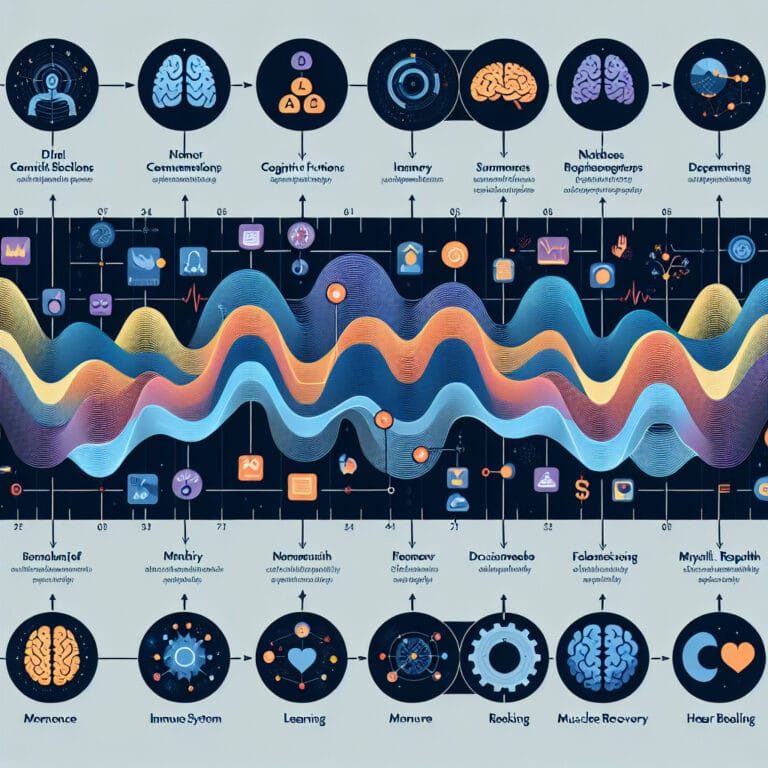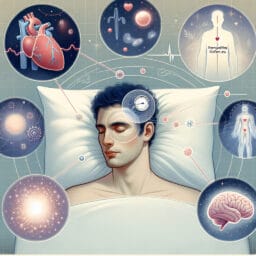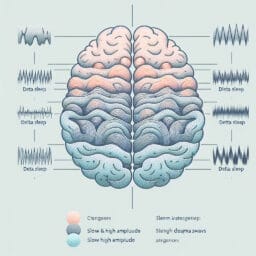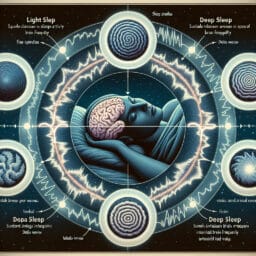
Understanding the Basics: Defining Sleep Architecture
Table of Contents
- Introduction
- Understanding Sleep Cycles
- The Science Behind Sleep Architecture
- The Importance of Healthy Sleep Architecture
- How to Improve Sleep Architecture
- Conclusion
- Frequently Asked Questions
Introduction
The world of sleep is far more complex and dynamic than simply closing our eyes and drifting off. Diving into the concept of sleep architecture reveals a fascinating structure to our slumber, governed by circadian rhythms and cycling through distinct stages like REM (Rapid Eye Movement) sleep, NREM (Non-REM) sleep, deep sleep, and even periods known as ‘quiet sleep’. Each stage presents unique characteristics – from rapid eye movements to slower brain waves, altered heart rates to muscular paralysis – reflecting changes in neurological activity. The journey from falling asleep fast through these cyclic transitions forms the crux of your personal sleep architecture. Moreover, changes or disruptions in this intricate structure can result in various sleep disorders such as insomnia or obstructive sleep apnea.
Understanding your own particular architecture enables a deeper insight into the quality of your rest. For instance, ‘deep’ or ‘slow wave’ NREM stages are responsible for physical rejuvenation and growth hormone release; REM stages play a pivotal role in memory consolidation. A well-balanced cycle between both defines normal healthy sleeping patterns. In contrast, issues like frequent waking during the night might hint at an impaired transition between nonrem and rem stages. Hence understanding this blueprint becomes essential for diagnosing problems with onset or duration of different stages within one’s personal ‘overnight study’.
Understanding Sleep Cycles
Unraveling the fascinating elements of sleep architecture, we cast light on the structured procession through different stages that our bodies navigate every night. These stages include NREM Stage 1, NREM Stage 2, NREM Stage 3, and REM stage. The nuances of each stage are marked by unique brain waves and eye movements, contributing to a balanced sleep cycle necessary for optimal health. The first part of your sleep cycle involves falling into ‘quiet sleep’; this is referred to as non-rem or NREM sleep which is further divided into three stages. Each sequential stage signifies a deeper level of slumber – from the lightest at NREM Stage 1 where theta waves dominate, progressing towards deep and restorative slumbers in third stage characterized by slow-moving delta waves.
The REM stage is an intriguing paradox; while our voluntary muscles enter a state of temporary paralysis signaling deep restfulness, our brain activity spikes resembling wakefulness alongside rapid eye movements. It’s during these REM cycles when most dreams occur and significant memory consolidation takes place.
Each individualized journey through these stages demonstrates personal sleep architecture patterns that define your overall quality of rest. It’s crucial to understand that disruptions within them can lead to prevalent sleep disorders such as insomnia or obstructive sleep apnea requiring consultation with asleep specialist. Thus it becomes imperative to monitor your own overnight journeys to ensure healthy transitions between these distinct yet interconnected realms within your nocturnal microcosm.
| Sleep Stages | Description | Characteristics |
|---|---|---|
| NREM Stage 1 | This is the lightest stage of sleep, often referred to as ‘quiet sleep’. | Theta waves dominate the brain waves during this stage. |
| NREM Stage 2 | This stage signifies a deeper level of sleep than Stage 1. | There’s a unique pattern of brain waves and eye movements. |
| NREM Stage 3 | Deepest and most restorative stage of sleep. | Characterized by slow-moving delta waves. |
| REM Stage | An intriguing paradox of deep restfulness and heightened brain activity. | Voluntary muscles enter a state of temporary paralysis, brain activity spikes resembling wakefulness, rapid eye movements, and most dreaming occurs. |
| Sleep Disorders | Disruptions within sleep stages that can lead to issues like insomnia or obstructive sleep apnea. | Can require consultation with a sleep specialist. |
The Science Behind Sleep Architecture
Brain waves, the rhythmic or repetitive neural activity in the central nervous system, play an integral role in structuring our sleep. As we transition from wakefulness to sleep onset and delve deeper into our sleep cycles, there’s a significant shift in brain activities observable through varying wave patterns. For instance, during the early stages of non-REM sleep, theta waves predominate indicating a calm and relaxed state. As we enter deep sleep stages or NREM Stage 3, slow-moving delta waves take over signifying restorative slumber where growth hormone release occurs, contributing to physical rejuvenation.
However, when these transitions are disrupted due to various neurological disorders or ailments like sleep apnea; it leads to alterations in normal sleep architecture leading to poor sleep quality. Sleep disorders often impose an irregularity in this seamless transit between different stages causing frequent awakenings (fragmented continuity), reducing deep-sleep time which can culminate into chronic insomnia overtime. In such scenarios one may require consultation with a sleep specialist who carefully evaluates their ‘overnight study’ recording all data including eye movements and heart rate dynamics for understanding patient-specific issues better.
Interestingly Mednick SC’s studies on quantifying sleep architecture dynamics shed light on how these distinct yet interconnected realms within our nocturnal microcosm contribute towards our overall health and cognitive functioning emphasizing that promoting balanced REM & Non-REM cycles is paramount for maintaining optimal well-being.
The Importance of Healthy Sleep Architecture
An integral aspect of our well-being, sleep architecture plays a significant role not only in our physical health but also impacts cognitive functionality. Mednick SC’s studies on quantifying sleep architecture dynamics shed light on how distinct yet interconnected realms within our nocturnal microcosm contribute towards overall health and cognitive functioning. Each stage of the sleep cycle, from quiet NREM sleep to deep REM stages, is marked by unique brain activity; these shifts in brain waves and eye movements help achieve memory consolidation and promote growth hormone release during restful slumber. Any disruption in transitioning smoothly through these sleep architecture stages can lead to common sleep disorders such as insomnia or obstructive sleep apnea.
Furthermore, a healthy circadian rhythm ensures that we fall asleep fast and achieve optimal deep sleep time necessary for bodily rejuvenation. However, neurological disorders or irregularities like frequent awakenings can cause alterations in the normal sequence of NREM and REM stages leading to poor quality of rest. In such cases, an overnight study conducted by a specialist often becomes essential; this recorded data provides an accurate understanding of one’s personal ‘sleep-wake cycle’, identifying potential issues affecting proper rest and suggesting effective remedies accordingly.
Therefore it is crucial to understand that maintaining balanced cycles between non-rem stages (quiet to deep) & rem stage is paramount – any deviation could disrupt the natural rhythm leading to depleted cognitive performance or chronic physical ailments over time.
How to Improve Sleep Architecture
Understanding and improving your sleep architecture holds the key to optimal health and cognitive function. Our bodies naturally cycle between non-REM stages, which include quiet sleep leading to deep sleep, and REM stage, characterized by rapid eye movement. This cycling pattern significantly contributes to quality rest. However, various factors can disrupt this delicate balance, leading to frequent awakenings or issues like insomnia and obstructive sleep apnea.
To improve your sleep architecture, consider making lifestyle changes. Managing stress levels through mindfulness techniques such as meditation can help achieve calmness necessary for onset of theta wave-dominated NREM Stage 1. Regular physical activity has been shown to promote longer periods of rejuvenating deep sleep or NREM Stage 3 where growth hormone is released for bodily repair.
Your diet also plays a role in regulating your circadian rhythm – the internal clock that dictates when you fall asleep fast and wake up. Consuming caffeine or alcohol close to bedtime may hinder the seamless transit from wakefulness to different stages within the ‘sleep-wake cycle’, disrupting normal sleep.
If lifestyle adjustments aren’t sufficient in resolving persisting problems with your personal ‘overnight study’, consult with a sleep specialist who might suggest medical interventions. An overnight polysomnography can record brain waves, heart rate dynamics, eye movements et al., providing an accurate diagnosis for tailored treatments aiming at restoring the balanced transitions between non-rem and rem sleeps essential for healthy cognitive functioning.
Conclusion
Our understanding of sleep architecture – the balletic cycle between REM and NREM stages – is key in comprehending our overall sleep quality. This intricate dance through deep sleep, quiet sleep, and periods of rapid eye movement greatly influences our cognitive function, physical health, and wellbeing. The disruption of this delicate balance can lead to sleep disorders like insomnia or obstructive sleep apnea as the brain activity fluctuations necessary for memory consolidation get disturbed. However, with intentional lifestyle changes including stress management techniques, regular exercise, and a balanced diet that aligns with our circadian rhythm, we can optimize these transitions within our ‘sleep-wake cycle’. In more severe cases involving neurological disorders or persistent issues with heart rate dynamics during slumber stage shifts, consultation with a sleep specialist can be invaluable. An overnight study can provide an accurate diagnosis by recording brain waves and eye movements throughout different stages of rest – from the onset marked by theta waves to moments of temporary muscular paralysis in REM stages. Indeed Mednick SC’s work quantifying such dynamics reinforces the importance of maintaining a healthy architecture for both physical rejuvenation through growth hormone release in deep NREM stages and robust memory functions attributed to REM cycles – an embodiment of optimal holistic health.


